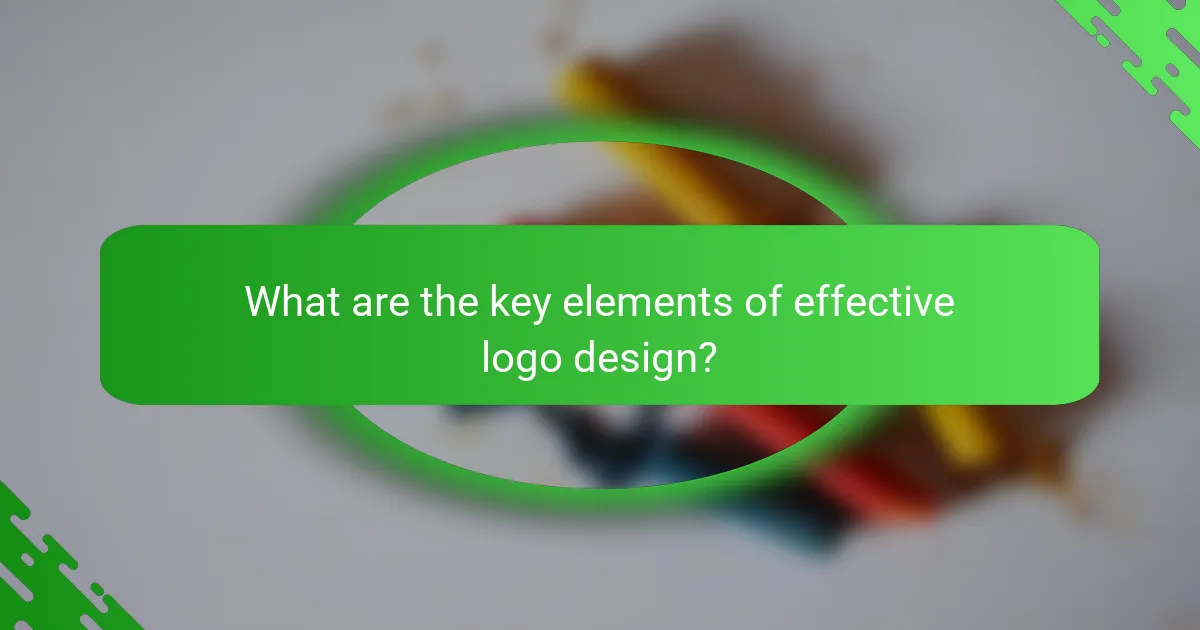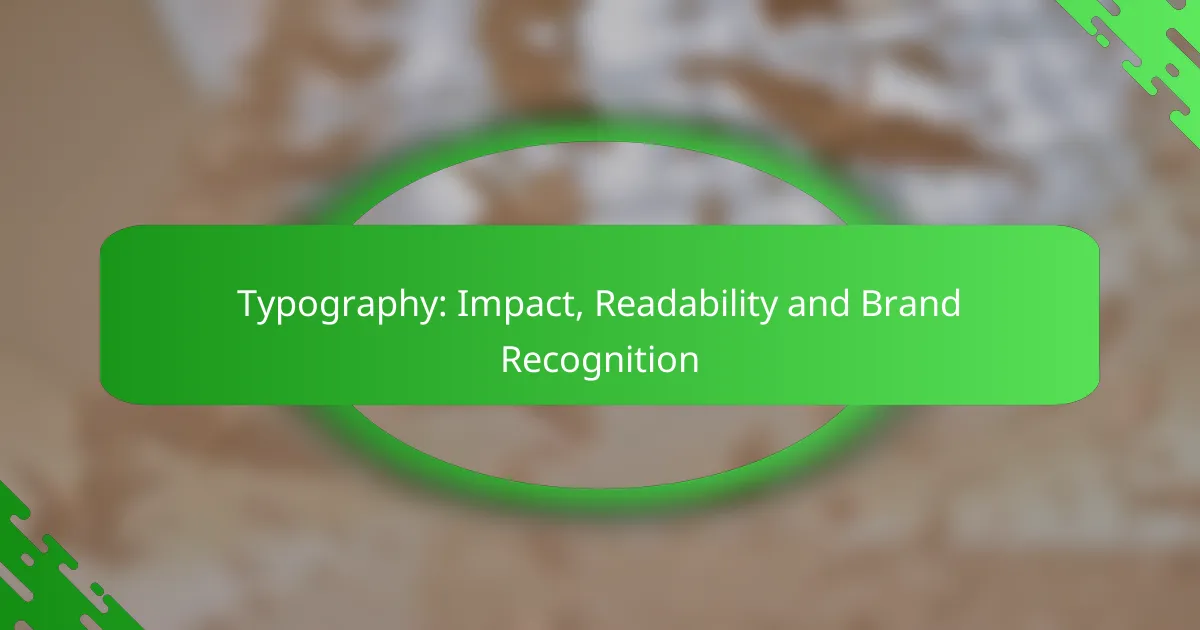Logo design plays a vital role in establishing a brand’s identity, with simplicity and memorability being key factors for success. By focusing on essential elements such as color, shape, and typography, designers can create logos that resonate with audiences and stand out in a crowded marketplace. A well-crafted logo not only enhances recognition but also ensures versatility across various platforms, making it an invaluable asset for any brand.

How to create a memorable logo design?
A memorable logo design is simple, distinctive, and easily recognizable. To achieve this, focus on key elements such as simplicity, color schemes, typography, and versatility across various platforms.
Focus on simplicity
Simplicity is crucial in logo design as it ensures that the logo is easily recognizable and memorable. A simple logo can be quickly identified and understood, making it more effective in conveying the brand’s message.
Avoid cluttered designs with excessive details. Aim for a clean and straightforward look that can be scaled down or up without losing its impact. Think of iconic logos like Apple or Nike, which are instantly recognizable due to their simplicity.
Utilize strong color schemes
Color plays a significant role in logo design, influencing emotions and perceptions. Choose a color scheme that reflects your brand’s identity and resonates with your target audience.
Consider using a limited palette of two to three colors to maintain visual coherence. For example, blue often conveys trust, while red can evoke excitement. Ensure that the colors work well together and are versatile enough for various applications.
Incorporate unique typography
Typography can set your logo apart and reinforce your brand’s personality. Select a font that aligns with your brand’s values and is legible across different sizes and formats.
Custom typography can enhance uniqueness, but ensure it remains readable. Avoid overly decorative fonts that may detract from the logo’s clarity. Brands like Coca-Cola and Google effectively use typography to create memorable logos.
Ensure versatility across platforms
Your logo must be versatile enough to function across various platforms, from websites to social media and print materials. It should look good in both color and black-and-white formats.
Test your logo in different sizes and backgrounds to ensure it remains effective. A good practice is to create variations of your logo, such as a horizontal and vertical version, to accommodate different uses while maintaining brand consistency.

What are the key elements of effective logo design?
Effective logo design incorporates several key elements that contribute to its success, including shape, color, typography, and brand relevance. These components work together to create a memorable and recognizable identity that resonates with the target audience.
Shape and form
The shape and form of a logo play a crucial role in how it is perceived. Simple geometric shapes often convey clarity and professionalism, while more intricate forms can express creativity and uniqueness. Consider using shapes that align with your brand’s message; for example, circles can symbolize unity, while sharp angles may suggest innovation.
When designing a logo, aim for a balance between uniqueness and simplicity. A logo should be easily recognizable and scalable, maintaining its integrity across various sizes and applications. Test your design in different contexts to ensure it remains effective.
Color psychology
Color psychology significantly influences how a logo is perceived and can evoke specific emotions. For instance, blue often conveys trust and reliability, while red can evoke excitement and passion. Choose colors that align with your brand values and the feelings you want to evoke in your audience.
It’s essential to limit your color palette to two or three primary colors to maintain simplicity and coherence. Additionally, consider cultural meanings of colors, as they can vary significantly across different regions. For example, white symbolizes purity in some cultures but can represent mourning in others.
Typography choices
Typography is a vital element in logo design, as it communicates your brand’s personality and tone. Choose fonts that are legible and appropriate for your brand identity; for example, serif fonts often convey tradition and reliability, while sans-serif fonts can suggest modernity and simplicity.
Limit the number of different fonts used in your logo to maintain visual harmony. Ensure that the typography complements the other design elements, such as color and shape. Test your logo in various sizes to confirm that the text remains readable and impactful.
Brand relevance
A logo must be relevant to your brand and its values to create a lasting impression. Consider how your logo reflects your brand’s mission, vision, and target audience. A logo that resonates with your audience can foster loyalty and recognition.
Conduct market research to understand your audience’s preferences and expectations. Analyze competitors’ logos to identify trends and differentiate your design. Ensure that your logo evolves with your brand while retaining its core elements to maintain continuity and recognition over time.

How does simplicity impact logo design?
Simplicity in logo design is crucial as it enhances recognition, scalability, and memorability. A simple logo is easier for audiences to identify and recall, making it more effective in brand communication.
Enhances recognition
A simple logo is often more recognizable than a complex one. When a logo is straightforward, it can be quickly processed by the brain, allowing consumers to identify the brand at a glance. For example, logos like Apple and Nike are instantly recognizable due to their minimalistic designs.
To enhance recognition, focus on using basic shapes and limited colors. Aim for a design that can be easily reproduced across various mediums, from business cards to billboards.
Facilitates scalability
Simplicity in logo design facilitates scalability, meaning the logo maintains its integrity and clarity at different sizes. A complex logo may lose detail when scaled down, making it less effective in smaller formats like social media icons.
When designing, consider how the logo will appear in various contexts. Test your design at both small and large sizes to ensure it remains clear and impactful. A good rule of thumb is to keep intricate details to a minimum, focusing on bold shapes and colors that stand out.
Improves memorability
A simple logo is more memorable, as it allows consumers to easily recall the brand. Research shows that people tend to remember simple designs better than intricate ones. This is crucial in a crowded market where brands compete for attention.
To improve memorability, create a logo that resonates emotionally with your audience. Use unique yet simple elements that reflect your brand’s identity. Avoid trends that may quickly become outdated; instead, aim for a timeless design that can endure over the years.

What are the best practices for logo design?
The best practices for logo design focus on creating a unique, memorable, and versatile visual identity that resonates with the target audience. Effective logos are simple, scalable, and relevant to the brand’s values and mission.
Conduct market research
Market research is crucial for understanding the competitive landscape and identifying design trends that resonate with your target audience. Analyze logos from competitors and related industries to determine what works well and what doesn’t.
Consider conducting surveys or focus groups to gather insights on consumer preferences. This feedback can guide your design choices and help ensure your logo stands out while aligning with market expectations.
Seek feedback from target audience
Gathering feedback from your target audience is essential to validate your logo design. Present multiple design concepts to potential customers and ask for their opinions on aspects like color, shape, and overall appeal.
Utilize online platforms or social media to reach a broader audience for feedback. This can provide valuable insights and help you refine your logo to better connect with your intended market.
Test logo variations
Testing different logo variations is a key step in the design process. Create several versions of your logo, adjusting elements such as color, typography, and layout to see which resonates best with your audience.
Consider A/B testing these variations in real-world scenarios, such as on your website or social media ads. Analyze engagement metrics to determine which logo performs better, ensuring that your final choice is both effective and memorable.

How to choose the right colors for a logo?
Choosing the right colors for a logo is crucial as colors evoke emotions and convey messages about your brand. A well-selected color palette can enhance brand recognition and appeal to your target audience.
Understand color meanings
Colors have specific meanings and associations that can influence how a brand is perceived. For example, blue often represents trust and professionalism, while red can evoke excitement and passion. Understanding these associations helps in selecting colors that align with your brand’s message.
Consider creating a color chart that outlines common color meanings to guide your choices. This can include shades like green for growth, yellow for optimism, and black for sophistication. Using this chart can simplify the decision-making process.
Consider brand identity
Your brand identity should drive your color choices. Think about the values and personality of your brand; for instance, a tech company might opt for sleek, modern colors, while a children’s brand may choose bright, playful hues. Ensure that the colors reflect your brand’s essence.
Test your color choices with your target audience to gauge their reactions. This can be done through surveys or focus groups. Feedback can help you refine your palette to better resonate with potential customers and strengthen brand loyalty.



